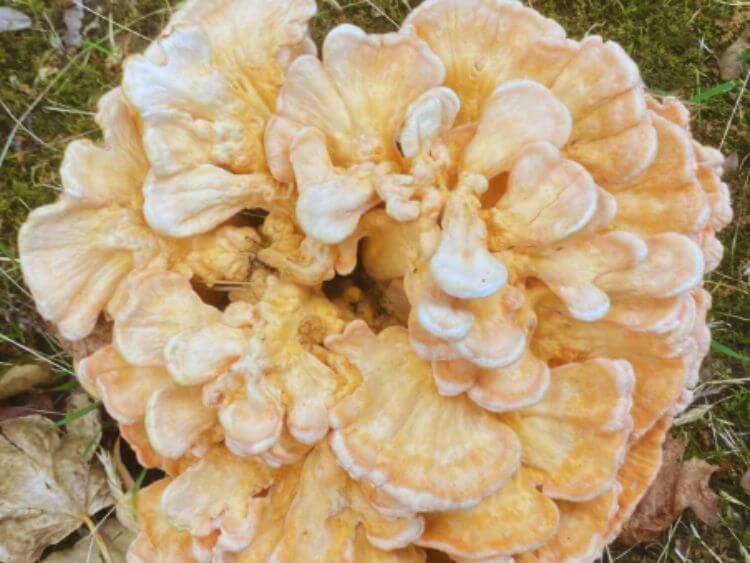Chicken of the Woods, a vibrant mushroom, is renowned for its unique texture and flavor, resembling chicken meat. This fungus, scientifically known as Laetiporus, is easily identifiable by its bright orange and yellow hues. It grows predominantly on dead or dying hardwood trees, making it a common sight in forests and wooded areas. Esteemed not just for its striking appearance, Chicken of the Woods has also garnered attention for its nutritional value, being a rich source of protein, fiber, and vitamins.
Popularity and Culinary Uses
The popularity of Chicken of the Woods extends beyond its intriguing name. This mushroom is a favorite among foragers and chefs alike, prized for its meaty texture and versatility in cooking. It’s a sought-after ingredient in vegetarian and vegan dishes, serving as a remarkable substitute for chicken. Its ability to absorb flavors makes it ideal for a variety of recipes, from sautéing to grilling. Its culinary uses are diverse, featuring in stir-fries, soups, and even as a pizza topping, offering a unique, savory twist to traditional dishes.
This article aims to provide a comprehensive exploration of Chicken of the Woods, delving into its nutritional profile, health benefits, and culinary applications. We will address common questions such as its edibility, preparation methods, and potential health implications. The goal is to offer readers valuable insights into this fascinating fungus, enhancing their understanding and appreciation. Whether you’re a seasoned forager, a culinary enthusiast, or simply curious about this unique mushroom, this article seeks to be an informative and engaging guide on all aspects of Chicken of the Woods.
Nutritional Profile of Chicken of the Woods
Chicken of the Woods is not just a culinary delight but also a nutritional powerhouse. A 100-gram serving of this mushroom contains approximately 36 calories, making it an excellent choice for those monitoring their calorie intake. It’s low in fat, with just 2 grams per serving, and high in dietary fiber, offering 6 grams, which aids in digestion and promotes a feeling of fullness. The carbohydrate content is modest at 7 grams, primarily consisting of natural fibers and minimal sugars.
Protein is another significant component, with Chicken of the Woods providing about 20 grams per 100 grams, a substantial amount for a plant-based source. This makes it an ideal protein substitute for vegetarians and vegans. In terms of vitamins and minerals, it’s a rich source of Vitamin C and Vitamin A, essential for immune function and vision health, respectively. Additionally, it contains 100 mg of potassium per serving, crucial for maintaining healthy blood pressure levels and proper muscle function. The presence of these nutrients makes Chicken of the Woods not just a tasty but also a healthful addition to any diet.
Health Benefits
Chicken of the Woods make it an excellent food choice for health-conscious individuals. Its high fiber content is beneficial for digestive health, helping to prevent constipation and maintain a healthy gut. Fiber also plays a role in weight management, as it contributes to a feeling of fullness, reducing overall calorie intake.
The protein content in Chicken of the Woods is particularly noteworthy. As a plant-based protein, it offers a sustainable and healthy alternative to animal proteins, important for muscle building and repair. This is especially beneficial for vegetarians and vegans looking to increase their protein intake.
Vitamin C, abundant in Chicken of the Woods, is vital for the immune system, helping to protect the body against infections and diseases. Vitamin A, also present in significant amounts, is essential for maintaining healthy vision, skin, and immune function. The potassium content aids in regulating blood pressure and heart health, making it a heart-friendly food.
Beyond these basic nutritional benefits, Chicken of the Woods is believed to possess potential medicinal properties. Some studies suggest that it may have anti-inflammatory and antimicrobial effects, although more research is needed in this area. Its antioxidant properties are also of interest, as antioxidants help combat free radicals in the body, potentially reducing the risk of chronic diseases like heart disease and cancer.
Can You Eat Chicken Of The Woods Raw?
While Chicken of the Woods is a culinary favorite, it’s important to note that consuming it raw is not recommended. Eating this mushroom in its raw form can pose health risks due to potential bacteria and harmful compounds that are present in many wild mushrooms. These bacteria can lead to digestive disorders, including stomach upset and nausea. Moreover, the cell walls of mushrooms are made up of chitin, a substance that human digestive systems struggle to break down. This can lead to gastrointestinal discomfort when consumed raw.
To safely enjoy Chicken of the Woods, proper cooking is essential. Cooking not only neutralizes potentially harmful bacteria but also breaks down chitin, making the nutrients more accessible and digestible. The recommended cooking methods include sautéing, boiling, or grilling. Sautéing with a bit of oil or butter over medium heat until the mushrooms are tender is a popular method. This enhances their natural flavors while ensuring they are safe to eat. Boiling in water or broth for a soup or stew is another effective method, especially for softer textures. Grilling adds a smoky flavor and is ideal for larger, firmer pieces. Regardless of the method, ensure the mushrooms are cooked thoroughly to enjoy their unique taste and nutritional benefits safely.
Related: Do You Need To Soak Chicken Of The Woods?, Are Chicken Of The Woods Healthy For You?, What’s the best way to eat chicken of the woods?
Side Effects and Precautions
While Chicken of the Woods is generally safe and nutritious, it’s important to be aware of potential side effects and take necessary precautions. One of the most common issues associated with consuming this mushroom is digestive disorders. Some individuals may experience stomach upset, nausea, or diarrhea, particularly if they are new to eating wild mushrooms or if the mushroom is not cooked properly. It’s crucial to start with small amounts to see how your body reacts before incorporating it into your regular diet.
Allergies are another concern. Although rare, some people may have allergic reactions to Chicken of the Woods. Symptoms can include itching, swelling, and difficulty breathing. If you experience any of these symptoms after consuming the mushroom, seek medical attention immediately. It’s always a good idea to try a small amount first if you’ve never eaten it before.
Identifying safe consumption is vital. Not all Chicken of the Woods mushrooms are edible; some varieties growing on certain trees like eucalyptus or conifers can be toxic. Always source your mushrooms from a reliable forager or supplier, and if in doubt, consult an expert.
Cooking and Preparation Tips
To ensure the best culinary experience and safety when preparing Chicken of the Woods, follow these best practices for cooking. Firstly, clean the mushroom thoroughly but gently to remove any dirt or debris. Avoid soaking them in water as they can become soggy; instead, use a damp cloth or soft brush.
When cooking, it’s essential to cook them thoroughly. This not only makes them safer to eat but also enhances their flavor and texture. Sautéing in butter or oil over medium heat until they are tender and slightly crispy on the edges is a popular method. This method brings out a savory, umami flavor that complements many dishes.
Grilled Chicken of the Woods with Herb Marinade
Ingredients:
- Chicken of the Woods mushrooms, sliced (quantity as desired)
- Olive oil – 3 tablespoons
- Garlic, minced – 2 cloves
- Fresh rosemary – 1 tablespoon, finely chopped
- Fresh thyme – 1 tablespoon, finely chopped
- Lemon juice – 2 tablespoons
- Salt and pepper – to taste
Directions:
- Marinate the Mushrooms: In a bowl, whisk together olive oil, minced garlic, chopped rosemary, thyme, lemon juice, salt, and pepper. Add the sliced Chicken of the Woods mushrooms to the marinade, ensuring they are well coated. Let them marinate for at least 30 minutes, allowing the flavors to meld.
- Preheat the Grill: Heat your grill to a medium-high temperature. If you’re using an indoor grill pan, make sure it’s nice and hot to get those beautiful grill marks.
- Grill the Mushrooms: Place the marinated mushroom slices on the grill. Grill for about 3-5 minutes on each side or until they are golden and have nice grill marks. The mushrooms should be tender but not overcooked.
- Serve: These grilled delights can be served atop a fresh salad, as a side to your main course, or even as a scrumptious vegetarian sandwich filling. They’re incredibly versatile!
Optional Serving Suggestions:
- Salad: Toss them onto a bed of mixed greens, cherry tomatoes, and a sprinkle of feta cheese.
- Sandwich: Serve them in a ciabatta with lettuce, tomato, and a spread of aioli.
- Side Dish: Pair with a quinoa pilaf or roasted vegetables for a wholesome meal.
More: Chicken of the Woods Recipe: A Culinary Guide
FAQs
1. Can Chicken of the Woods Be Eaten Raw?
No, it is not recommended to eat Chicken of the Woods raw. Consuming it in its uncooked form can lead to digestive issues due to potential bacteria and indigestible compounds. Cooking the mushroom thoroughly is essential to make it safe and more digestible.
2. How Can You Tell if Chicken of the Woods is Edible?
To ensure that Chicken of the Woods is edible, look for mushrooms growing on hardwood trees like oak and avoid those on conifers or eucalyptus, as these can be toxic. The mushroom should have a bright orange or yellow color, and it’s best to choose younger, tender specimens. If in doubt, consult an expert forager or mycologist.
3. What Are the Best Ways to Cook Chicken of the Woods?
Chicken of the Woods can be cooked in various ways, similar to other mushrooms. Popular methods include sautéing, frying, baking, and grilling. It’s important to clean the mushroom thoroughly before cooking. For a simple yet flavorful preparation, sautéing with garlic, shallots, and herbs is recommended. The mushroom’s meaty texture makes it versatile in dishes like pasta, risotto, and as a meat substitute in vegetarian recipes.


